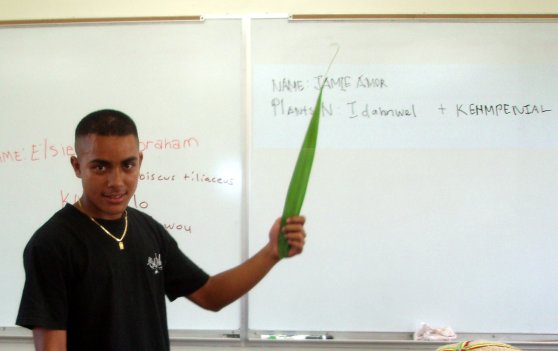
Elsielynn Abraham presented the Pohnpeian use of pounded keleu (Hibiscus tiliaceus) leaves to keep hair long and healthy.
Meriko Alik noted the many important uses of remek {Scaevola taccada) in Pingalapese culture. For certain types of women's sickness the leaves are pounded and squeezed through a clean cloth. The woman then drinks the juice. The juice of young leaves helps prevent post-event soreness in athletes. The white fruit is used in the treatment of pink eye.
Jamie Amor of Pohnpei reported on the use of a mix of idahnwel (Flagelleria indica) and kehmpeniel (Psychotria hombroniana) in pwuriamwei medicine for babies. Pwuriamwei is a culture bound syndrome that translates directly as "surprise" and more accurately as "startle" or "fright." If a baby becomes startled or frightened, the baby may stop eating and even lose weight. The leaves are pounded together, possible four or eight leaves. The juice is squeezed onto the fontelle. Discussion suggested that four drops was probably a likely number of drops, although two was a possibility. The liquid might be very gently rubbed around.

Jayce Antreas of Pohnpei covered the use of four young guava (kupwuden kuapa) leaves to treat mehn tang (diarrhea).
Midion Andrew of Kapinga covered the importance of fermented nonu (Morinda citrifolia) juice as a tonic.
Jörg Anson from Kitti noted similar uses of roamoak {Scaevola taccada)to those enumerated by Meriko.
Jefflyn Anton also covered Scaevola taccada, kusrohsr and its use to treat pink eye on Kosrae.
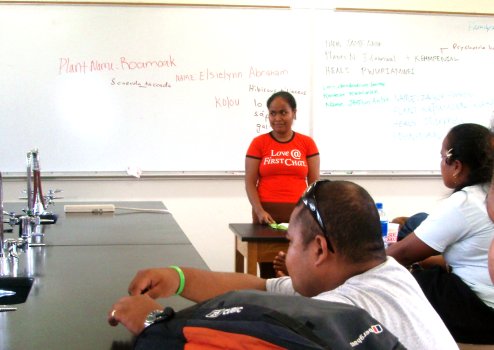
Emily Benjamin covered treating a headache by pounding karer (Citrus aurantifolia) leaves, mixing with oil, and then massaging the oil over the whole body.
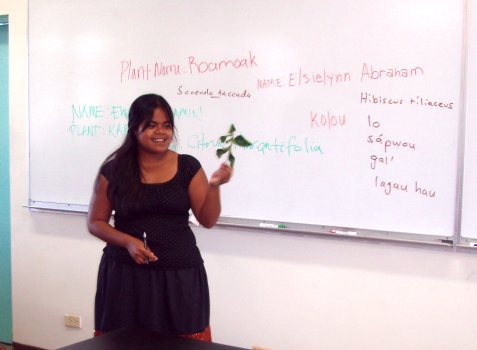
The class listens to Emily presenting. These presentations always engender interest. Students also sometimes get so excited about how a particular plant being presented is used on their own island that they get lost in a side conversation about the plant. Other times they are side tracked by discussions of what a plant is called in their language. There is never enough time in the period to fit in all the discussions that these presentations spawn.
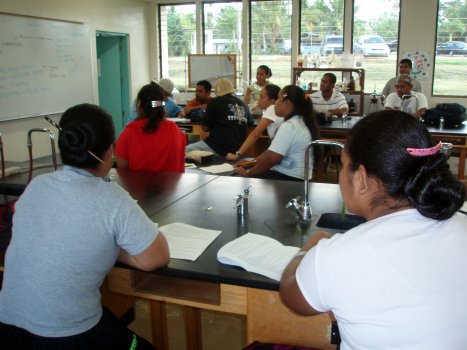
If one is cut and bleeding on Yap, one of the treatments is the juice of the leaves of the malay plant according to Julia Layan. This plant, commonly found growing under trees in cool shady places will staunch the bleeding.
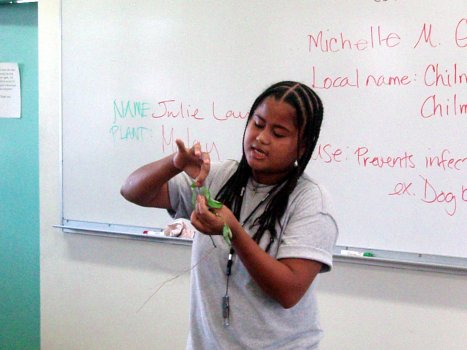
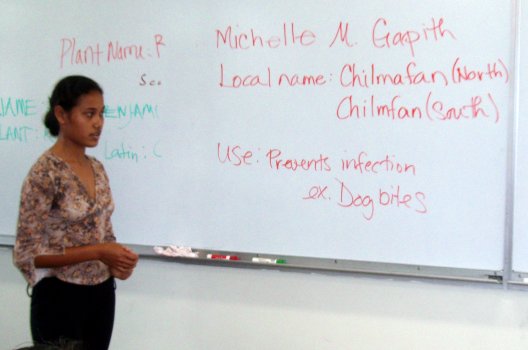
After staunching the bleeding, puncture type wounds can be disinfected with the juice of the leaf of Centella asiatica. Michelle Gapith of Yap noted that in the north this plant is called chilmafan, in the south the plant is called chilmfan.
Stallone Ham noted that in Chuuk rather than chewing guava leaves (machangen kuafa), in Chuuk a tea is made from the leaves to treat diarrhea. Corbette Yamaguchi helpfully noted that overdosing could be painful.
Garry Ifenuk covered treating heartburn by chewing coconut leaves (cheen nu).
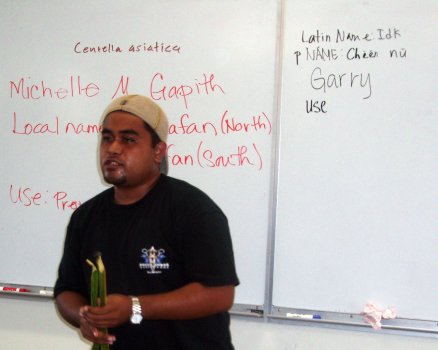
Maimi Ioanis of Kitti explained the use of the young, curled tips of toahlik (Asplenium nidus) leaves in the treatment of displaced uterus. Four tips, or eight, still furled are used. These tips are produced towards the end of the fiddlehead stage. Symptoms of displaced uterus can include abdominal pain and back pain. This medicine can only be used once, and if the medicine does not work then the nature of the problem is different and other medicines must be used. This medicine might be used in the case where a uterus was displaced either by sexual overactivity or overly rough intercourse. If this author understands correctly, the medicine carries a meaning, a warning, to the young woman. As the medicine cannot be used a second time, there is a subtext warning to the young woman to change her ways. My thanks to Maimi for sharing this deeper cultural context in which the medicine is used. Local medicines are often both curative and possessed of social meanings.
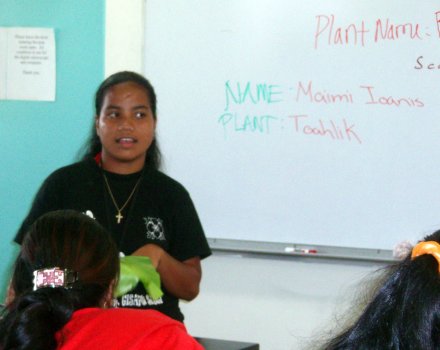
Sinolet Lekka of Pohnpei shared the use of reh takai (could be Chrysopogon aciculatus or Eleusine indica) to treat dysmenorhea in the form of an ongoing menses that does not end. The roots are cleaned in hot water, pounded, and the [juice?] is consumed twice a day for two days.
Divine Grace Lokopwe of Pollap shared the use of kipwau (papaya in Pollapese) to treat the pain of a centipede pain. Cut a green papaya in half, put sticky white latex on centipede bite. There is a side effect of itching, but the intense pain of the bite is counteracted by the latex.
Juslyn Nena of Kosrae covered the use of a morning glory to treat headache. She refered to the plant as oa, (Ipomoea pes-caprae) but later recanted noting she had confused oa and owopuk (Ipomoea littoralis).
Pertin Paul of Pohnpei covered the use of madeu (Cinnamomum carlinense) to improve circulation and reduce pain. He noted that the bark (outer layer) can pounded and mixed with the pounded bark of a second tree to treat internal bleeding. Madeu bark can also be boiled and pounded and mixed with the outer layers of a mangrove tree to [stablize cancers?] in the body
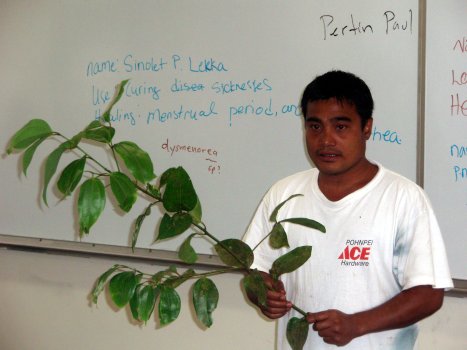
John Rousan Jr. of Faichuuk covered owon, possibly strangler fig. The closed young leaves are used to treat blood in the eye. The pounded leaves are blown through a papaya leaf stem "straw" into the eye to treat bleeding in the eye as might occur after being hit in the eye.
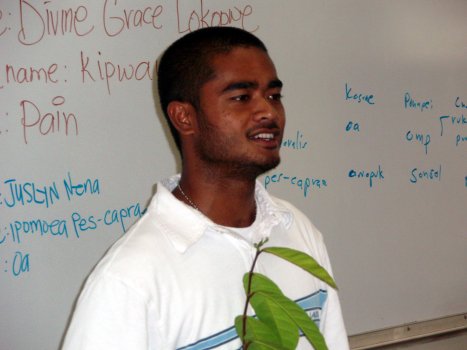
Lyna Seymour of Kosrae covered the use of ii (Morinda citrifolia) roots to treat toothaches. The root is cleaned, pounded, and the juice is squeezed through a cloth into the painful abscess in the mouth. The class listened and took notes.
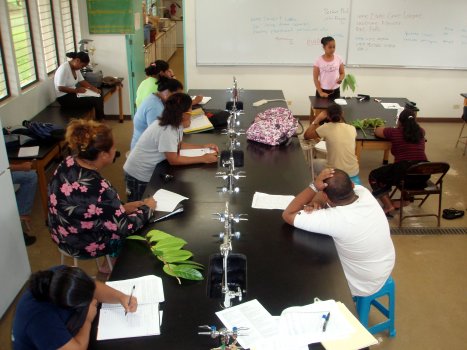
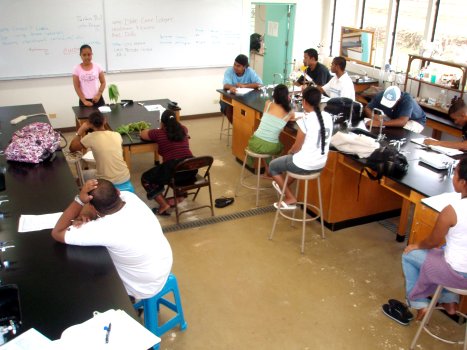
Ihney Sohswel of Pingelap covered the use uhpwul (Morinda citrifolia) to heal men's illnesses.
Lisa Lollaine Soram of Pohnpei explained the use of pisetikmei (alternately pisetikimei, Melastoma malabathricum var. marianum and iol (alternately iohl, Merremia peltata) to treat sprains. Four of the red growing tips of the iol vine are mixed with four leaves of pisetikmei and applied to the sprain.
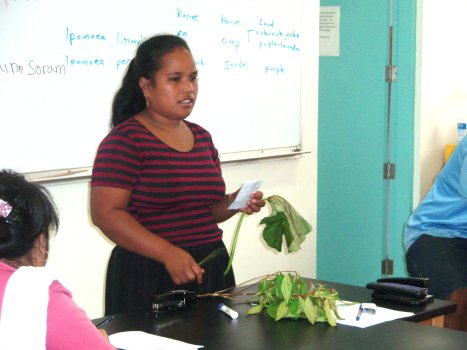
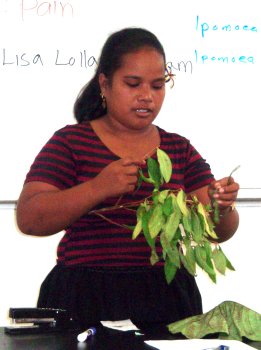
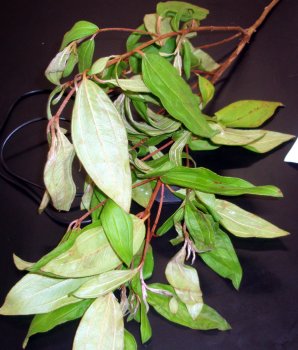
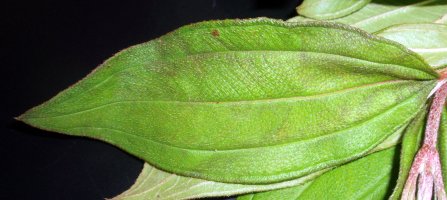
Elterina Taulung of Kosrae noted the use of the juice of puhlah fruit (Merremia peltata) to treat burns and prevent scars due to burns. She noted that the juice should be applied using a chicken feather. If this author understood correctly, the juice is held in a coconut half shell.
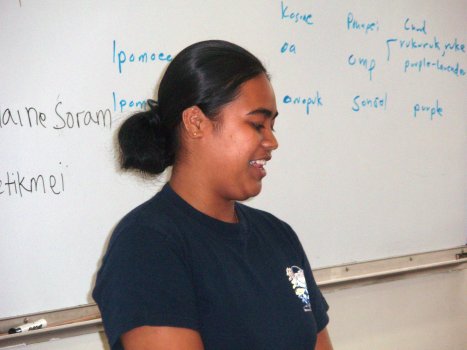
Mary-Vic Tihpen of Madolehnihmw in Pohnpei bravely took on explaining a culture bound syndrome. She noted the use of four young rahmedel sakau leaves (Piper methysticum var.) and four pinnae of rehdil (Nepholepis acutifolia or possibly N. biserrata) to aid in easing the memories of and forgetting a former lover who has left you. If your husband or wife leaves you, this potion can make you forget about them, move on, get over the pain, and ready you for a new love. The four sakau leaves are pounded along with the four pinnae of the rehdil, placed in a cloth, immersed in a glass of water, and squeezed until the water is green. Drink this twice a day for four days, once before sunrise and once before sunset. If you are still disturbed by the memories of the lost love, continue for another four days. You are now ready for a new love.
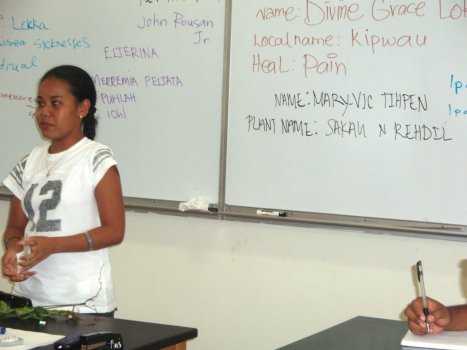
The instructor noted that this type of illness is a culture bound bound syndrome, and would be unique to Pohnpeian culture. John Rousan Jr. concurred, noting that the medicines in Chuuk were all geared towards getting the lover who left you to return to you, or to gaining the attention of someone who does not currently like you. Julia Layan of Chuuk, after some discussion with Michelle Gapith, concurred with John. Later she would confirm that the medicines worked best in getting someone to like you if the person did not currently like you. Mary-Vic showed great condidence and personal courage in choosing to share a sensitive culture bound syndrome and its treatment.
Bercil Timothy of Kosrae explained the use of sra kito (Senna alata, formerly Cassia alata) to treat ringworm fungus of the skin. this plant is used in this fashion across Micronesia.
Andrew Weito of Chuuk addressed the use of warung (Ocimum tenuiflorum) in an apwos (steam bath or sauna bath). Kosraens call this form of treatment srawuck while the Pohnpeians call it uhmlap. Julia and Michelle concurred that such treatment is used in Yap, but could not think of what the treatment is called. Divine Grace noted that this treatment - breathing the steam from a plant immersed in boiling hot water and sweating while under a sheet - is also done in Pollap. Warung (aring in Kosrae, kadiring in Pohnpei, lamar in Yap) is often used in a steam bath for nasal congestion, colds, and the headaches and fevers associated with colds.
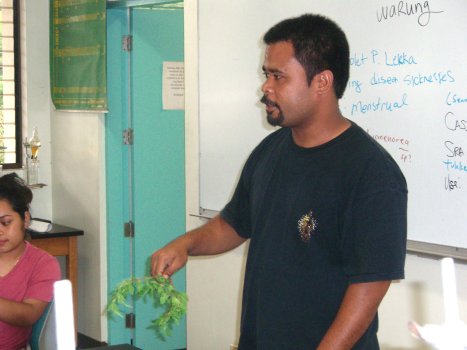
Corbette Yamaguchi wrapped up the session with multiple uses of weipwul (Morinda citrifolia). He noted a unique treatment for a sty in the eye. The central vein of a mature leaf is brought near the eye, the top of the leaf down. The leaf is snapped near the petiole right in front of the eye, thus spraying the eye with juice from the central vein. This procedure is repeated until the tip of the leaf is reached. Puncture wounds from rusty nails can be treated with the juice of the outer skin of this tree. The roots can be boiled and the liquid then consumed to build up one's blood supply. And the ripe fruit treats a particular type of soumwahuen ohl (men's sickness).